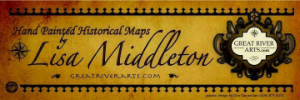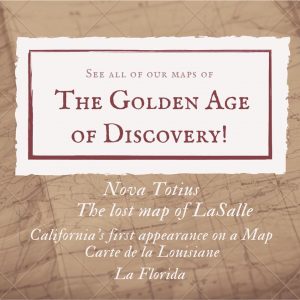OLD MAP STUDIES: A Timeline of The Age of Discovery and Notable Explorations
To Be updated!
The Age of Discovery and Exploration began around the 15th Century. Over the centuries there
were many technical advancements in ship and map making and they reached an apex for most
Europeans (save the Vikings) in the 1400’s. The Age of Discovery largely began with the King of
Portugal known as Henry the Navigator (1394 to 1460). His naval fleet first captured the port of
Ceuta in Morocco from the Moors in 1415. This inspired Henry to want to continue the
expansion of his empire and to seek out new lands. Between 1419 and 1460, he sponsored 8
voyages. From these 8 expeditions, the following discoveries and settlements were made:
- 1419 Settled Madeira
- 1431 Settled Azores
- 1434 Reached Cape Bojador
- 1441 Cape Blanco
- 1445 Cape Verde
- 1460 Guinea Coast
- 1460 Henry the Navigator passes away. By this time other countries are following Portugal’s lead and explorations grow in frequency over the next few hundred years.
- 1462 Sierra Leone and further into Africa
Pedro de Sintra lands of Sierra Leone and names it. He then voyages further into Africa around:
- Cape Palmas
- Cape Tres Puntas
- 1471 The Gold Coast : Joao de Santarem and Pedro Escobar reach the Gold Coast of Africa.
- 1482-84 Cape Lobo : Diego Cao travelled to the Congo and Cape Lobo.
- 1487 India through Egypt : Peroda da Covilhao reaches India thru Egypt and the Red Sea. He visited Calicut, Cananor and Goa. Later on, he settled in Abyssinia. He became the diplomat for Ethiopia from Portugal.
- 1487 Cape of Good Hope: Bartholomew Dias passed the Cape of Good Hope or Cabo de Boa Speranza. For the first time known, a European has passed the Cape of Good Hope and landed on the East Coast of Africa.
- 1494 Treaty of Tordesillas : Treaty of Tordesillas was signed between Portugal and Spain. The Treaty provided that Portugal had possession of all newly found lands btwn 45 degrees West and 130 degrees East allowing them to have a monopoly on the Cape routes to India and the East whereas Spain had possession of anything West of that line which included all the New World except for NE Brazil.
- 1492 Discovery of Hispaniola and the Americas: Italian navigator Christopher Columbus sailed in search of new territories and spices. He becomes credited with discovering the “New World.” He did not technically discover America however, he landed on what was thought to be Hispaniola and discovered the existence of Central and South America. Using Martellus round map, it now becomes much more widely accepted that the World is not flat. (Even though this has been known in educated circles since the time of the Greeks).
- 1497 English Discovery of Northern America: John Cabot was an Italian explorer commissioned by Henry V of England to try to find alternate routes to Asia. He was the first European since the time of the Norse expeditions in the 1100’s (which were not widely known to other Europeans at that time) to reach North America. He explored some parts of the Northeast coast of North America.
- 1497 to 1499 Sail around Africa to India: Portuguese Explorer Vasco de Gama becomes the first person to sail around Africa, discovering a new trade route to India. This route has been long sought after. 1500 First Permanent European Settlement and Crossing of the Isthmus of Panama. Spanish Explorer Vasco Nunez Balboa was the first European to cross the Isthmus of Panama, which at the time was known as the South Sea. He came across the island of Hispaniola and built the first permanent European settlement on it. It later became known as Panama.
- 1502 Discovery of Brazil: Italian Explorer Amerigo Vespucci lands on Brazil but thought he was in India. He called the Brazilian people Indians, a name which still extends to the indigenous people. America is later named after him.
- 1519 First Circumnavigation of Earth: Portuguese explorer Ferdinand Magellan was hired by King Charles I of Spain to search for the Spice Islands. He did not complete the entire voyage as he was killed in the Philippines in 1521 but he was credited with First Circumnavigation of Earth. Of the 270 men he took on his expedition from several nations, only one ship survived and returned to Spain with 18 crew members left.
- 1580 Transfer of Portuguese Trading Posts to the English and Dutch: By 1580 Portugal could not maintain their empire anymore because of cost and united with Spain. The trading posts of Goa, Diu, Macao, Timor and the East Indies remained under Portugal. The rest of the trading ports fell into the hands of the Dutch or the English.
- 1606 First Landfall on Australia: Dutch Explorer Willem Janszoon becomes the first European known to have landed on Australia.
- 1642 Discovery of Tasmania and New Zealand: Abel Tasman sailed from Mauritius and discovers Tasmania and New Zealand.
- Mid 1700’s The Cook Islands and Farthest Known Sail South to Date: James Cook sailed the furthest south than anyone is known to have at that time and is credited with discovering Cook Islands. He also explored Australia, Hawaii, New Zealand and Northern America.
- 1803 First American Transcontinental Crossing: McKinsey makes the 1st transcontinental crossing of North America.
- 1804 Second American Transcontinental Crossing: In May 1804 Merriam Louis and William Clark make the 2nd transcontinental crossing of America. They explore widely and map America with army volunteers commissioned by President Thomas Jefferson.
- 1831 Beagle Naturalist Explorations of South America: Charles Darwin is invited on the Beagle Explorations and spends five years exploring and charting the coastline of South America. This expedition included the naturalist exploration of Galapagos, Ecuador, where Darwin formulated his theories on evolution. He calls the Beagle Expedition the most important event of his life.
- 1851 – 1860 Discovery of Eastern Africa and Arabian Literature: English Explorer Sir Richard Burton explored the Americas, Asia and Africa extensively. His first expedition was to Mecca in Saudi Arabia and he is most known for bringing back and having translated the tales of 1,000 and 1 Arabian Nights with stories such as Alibaba and the 40 Thieves, Aladdin and the Magic Lamp. He also worked as a diplomat in Equatorial Guinea, Damascus and Brazil and was revered for being able to speak up to 29 languages.
- 1854- 1866 Deeper Explorations into the African Continent: David Livingstone was one of first Westerners to travel across Africa starting with an expedition in an attempt to discover the source of the Nile River. He did not find the source of the Nile River as he had hoped but he traveled extensively through Africa and discovered Victoria Falls and numerous lakes.
- 1898 First Solo Travel Around the World by Boat: American Joshua Slocum becomes the first Man to Travel around the World by himself on his boat Spray. It took him 3 years to travel 48,000 miles. He wrote the book “Sailing Alone Around the World.”
- 1910 to 1911 South Pole: Norwegian Explorer Roald Amundsen in December 1911 becomes the first person to reach the South Pole.
- 1928 Northwest Passage: Roald Amundsen also becomes the first to navigate the Northwest Passage in the Arctic in 1928. He also is the first person cross the Arctic by airship crossing from Oslo, Norway and landing in Alaska.
- 1955 First Flight Across the North Pole: Louise Arner Boyd, known as the “Ice Woman”, becomes the first woman to fly across the North Pole. She discovered a chain of sea mountains in the Arctic Ocean.
See our maps of early discovery! https://great-river-arts.myshopify.com/products/educational-map-series-californias-first-appearance-on-a-map ; https://great-river-arts.myshopify.com/products/educational-map-series-the-lost-map-of-sir-francis-drake, https://great-river-arts.myshopify.com/products/educational-map-series-universalis-cosmographia-1507, https://great-river-arts.myshopify.com/products/educational-map-series-carte-de-lamerique-septentrionnale-1910 , https://great-river-arts.myshopify.com/products/educational-map-series-orteliuss-regionis-typus-1570 , https://great-river-arts.myshopify.com/products/nova-totius-terrarum-1605-hand-colored-laser-reproduction


No comments yet.